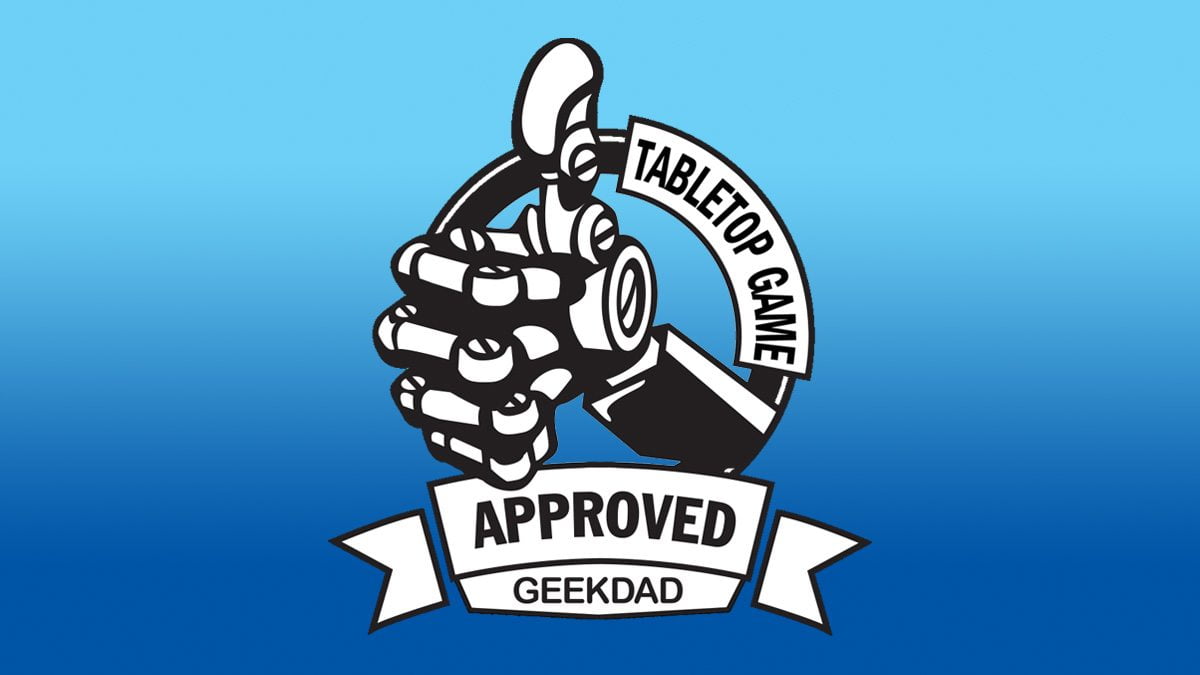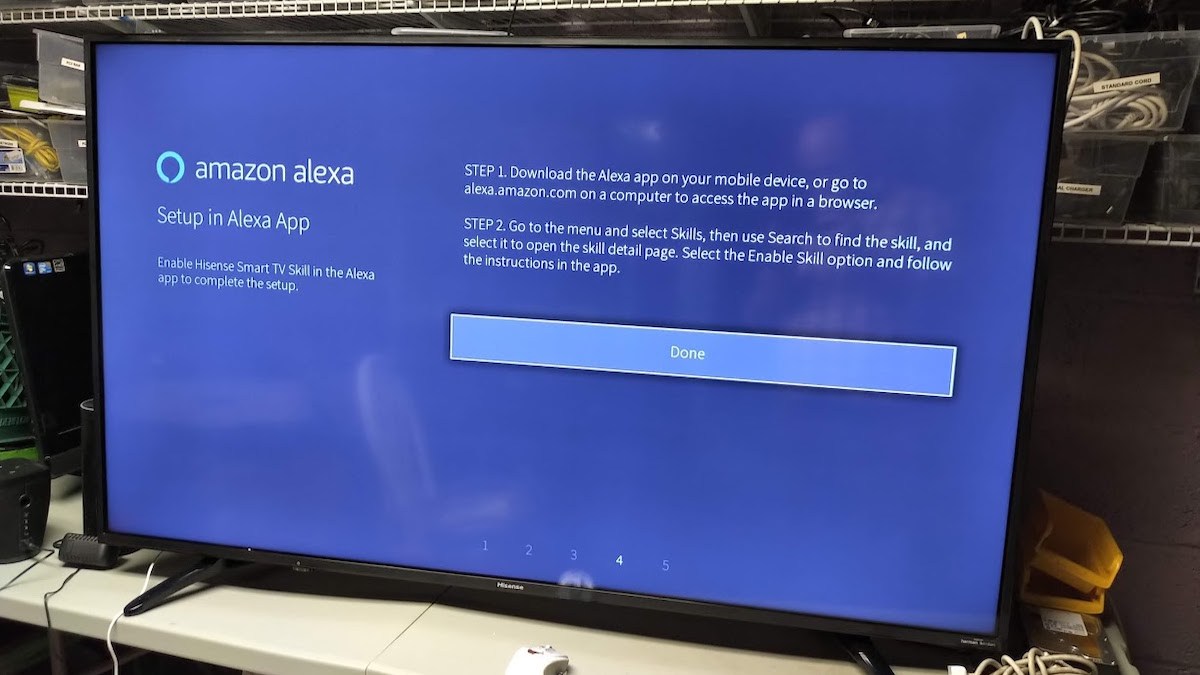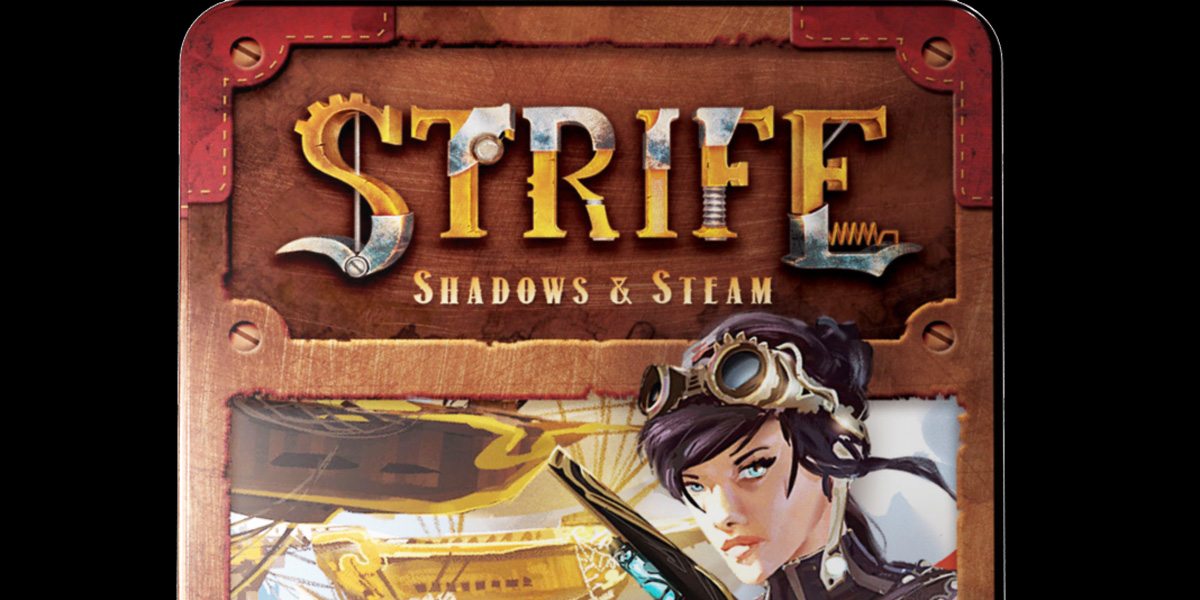You can almost hear the revving engines, squealing tires, and the roar of the crowds in Thunder Rolls. Get ready to race!
In “Reaping the Rewards,” I take a look at the finished product from a crowdfunding campaign. Thunder Rolls was originally funded on Kickstarter in the summer of 2021, and was shipped to backers in fall of 2022. It is now available for purchase, but there is also an opportunity to back a new campaign for the expansion as well—more on that later! This review is adapted from my Kickstarter Tabletop Alert, updated to reflect the finished product.
What Is Thunder Rolls?
Thunder Rolls is a stock car racing game for 1 to 8 players, ages 10 and up, and takes about 30 to 60 minutes to play. It retails for $89.99 (but the publisher Mr. B Games currently has it for $69.99; you can also get it on the current Kickstarter for a $59 pledge but you may have to wait longer for it). It’s definitely something that kids will be able to play, though it will help to have an older or experienced player to keep track of the rules, since some of the actions can be a little confusing at first. The game length is affected by the number of players and the type of race.
Thunder Rolls was designed by Richard Launius and co-published by Mr. B Games and Zeroic Games, with illustrations by Jack Hoyle.
New to Kickstarter? Check out our crowdfunding primer.

Thunder Rolls Components
Here’s what comes in the box:
- Race Track board (double-sided)
- 8 sets of player components:
- Team tile
- Race car
- 8 dice
- Score token
- Lap token
- 12 Speed cards
- 44 Thunder cards
- 12 Hazard cards
- 16 Crew Chief cards
- 16 Non-Player Action cards
- 16 Non-Player Driver cards
- 16 Qualifying cards
- Pole/Leader token
- Reference card
- 3 Red Flag tokens
- 6 No Passing tokens
- 24 Solo Mode Dice Simulator tokens
- 6 Advanced Rules cards
- 12 Weather cards
- 4 Alert tokens
- 19 Race cards
- Sticker sheet
The board itself is quite large at 34.5″ wide, so make sure you have a big enough space for it (plus every player needs a little bit of space for their team cards and programmed cards, and there’s a row of small cards along the bottom edge of the board as well). The board is double-sided, with two different tracks to use. Note that some of my photos are on custom neoprene mats, which were not for sale originally (the developer gave them to me) but are available as an add-on in the current Kickstarter campaign.
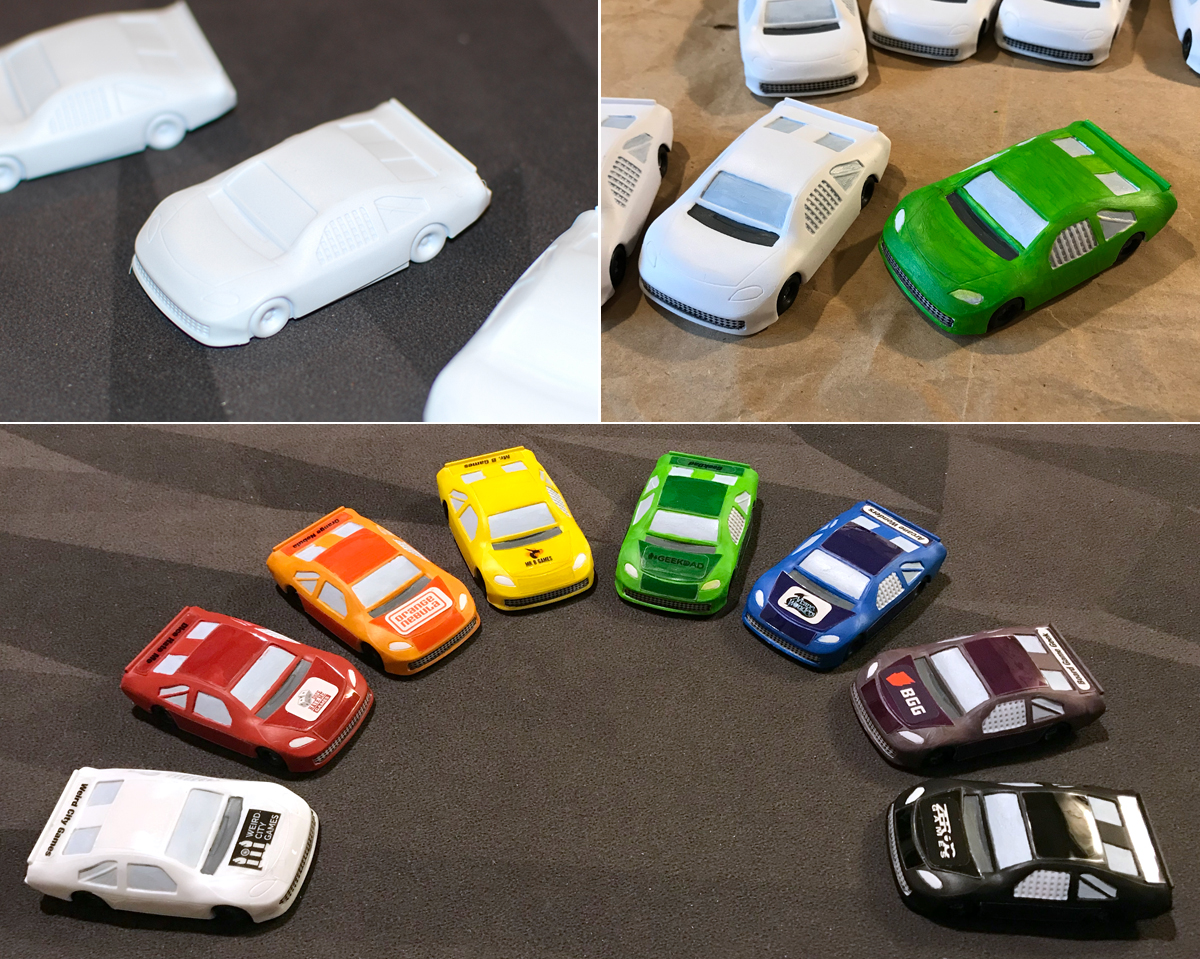
The cars themselves are pretty fun: they’re wide and chunky, and they look pretty great on the track. They’re not quite as big as Hot Wheels cars, but they’re close. The cars themselves are white plastic when they arrive, and there are sticker sheets included so that you can add colored panels, numbers, and sponsor names (including GeekDad!) to the cars. I decided I wanted a little more than just the stickers so I did a base color coat on each car and added a few details, though I’m not very experienced with painting miniatures so I didn’t attempt anything too fancy like racing stripes or other patterns. I also haven’t actually numbered them yet: the stickers came in a transparent version and an opaque version, but the opaque version has white backgrounds and the transparent stickers are also transparent on the parts that would be white (like the numbers themselves, so I hadn’t decided how I want to do those yet.
Most of the cards are small cards, and there’s room for the various decks in the center of the racetrack; they mostly just have large numbers and a few action icons on them, so there’s not a lot of room required for text, and it saves some room on the table (even though I’m generally not a big fan of small cards). We’ll get into the cards a bit more in the gameplay section. The cards do have illustrations on them—each deck has its own background illustration—though they’re fairly tiny. There are larger illustrations on the team cards and the action spaces on the board, and they’re a good mix of racing images that help set the scene.

The team tiles show a driver on one side and the pit crew on the other—you flip it over when it’s been used to re-roll your dice. At the top of the card are four arrows, used for when you program your movement. It’s a bit larger than a tarot card so it’s kind of big for the amount of information that’s actually on it, but it does make it easier to glance around the table to see which color car each player is.

While there are only two tracks to choose from, the race cards change up the feel of the race by providing some special rules—for instance, whether the orange or blue triangles on the track cause particular effects, how many stages the race will be, and how many dice are used. With 19 race cards, you get a wide variety to choose from. For some reason there’s only one reference card included, and that seems like an oversight—it would be nice to have a few more to share, given the number of different actions to keep track of.

The box is a large square—slightly bigger than, say, Ticket to Ride, but it still fits on a Kallax, and it has a custom plastic insert that is almost great. The insert stores the dice underneath each car, has some nested wells for some of the cards and team tiles, and then various wells for the cardboard tokens. For some reason there is one large well for the small cards, but then two very shallow wells between the cars, and it’s not entirely clear which cards are intended to go there but they all just about fit. The problem is that the insert was designed to hold the punchboard, with the game board on top. Once you punch everything out, the game board is too big to fit into the punchboard space, so if you dispose of the punchboard then there’s a gap where everything can slip out if the box is stored vertically. And the irony is that the board isn’t the full size of the box, so maybe if they’d just made the box the same size as Ticket to Ride then they wouldn’t need that little lip that prevents the board from resting directly on the rest of the insert. My solution is to just keep the punchboard there, but I don’t really like it.

How to Play Thunder Rolls
You can download a draft of the rulebook here. Note that there are solo rules in development, but I have only played the multiplayer version.
The Goal
The goal is to win the race, of course, but you can also set up a multi-race championship and track points for each place per race.
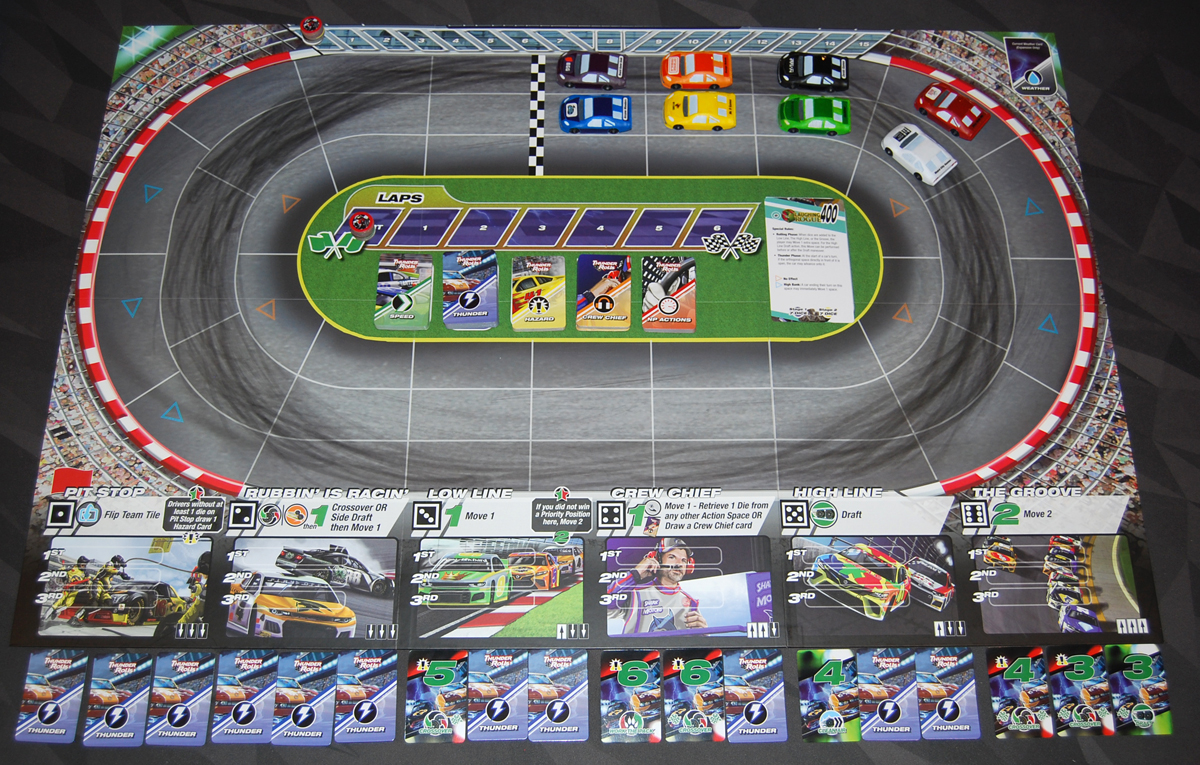
Setup
Choose a race card to use, and set out the board showing the indicated track.
Give each player a team card, race car, and dice of their chosen color, placing their lap marker and scoring marker on the board near the corresponding tracks. For any colors that were not chosen, place the corresponding Non-Player Driver (NPD) card nearby—the car and tokens will still be used, but not the dice.

Shuffle all of the decks individually, and place them in their spaces in the center of the board. Deal each player 2 Qualifying cards. Each player chooses one to keep and discards the other. Then all of the cards are revealed, and the cars are placed in the 8 starting spaces, with the highest Qualifying number taking the first spot. (NPDs have a qualifying number printed on them.) Some of the lower numbers have an ability printed on the bottom of the card—if so, the player should keep the card for use later. Give the player in position 1 the pole position token.

Deal Thunder cards along the bottom of the board, 3 below each action space. The arrows indicate whether the cards should be placed face-up or face-down.
Gameplay
The races are either 1 or 2 Stages, and each Stage has a Rolling phase followed by a Thunder phase. During the Rolling phase, players roll dice and place them into the various action spaces on the bottom of the board to take those actions and bid on the Thunder cards for that section. During the Thunder phase, players program 4 actions using Thunder cards and Speed cards, and then play them out.
Rolling Phase
Each round starts with the player in the lead position, goes clockwise around the table, and concludes with any NPDs. This is repeated until all players are out of dice.
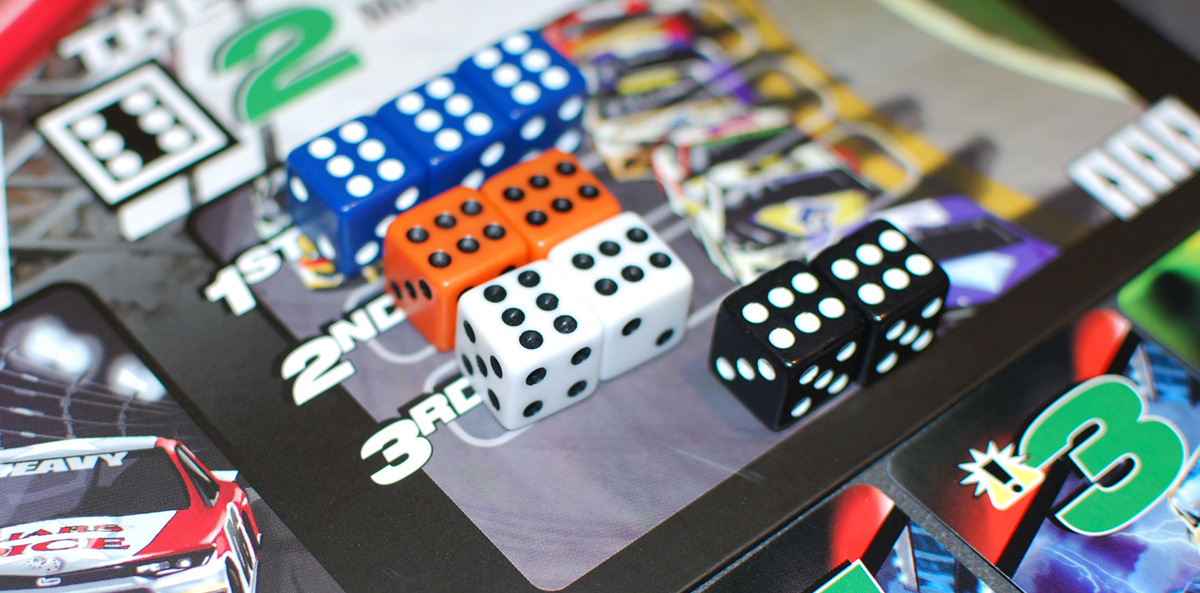
Everyone rolls the dice in their pool, and groups them by number. On your turn, you must place all of your dice of one value into the matching action space, ranked by the number of dice you have in that space. (If you’re adding dice to a space where you already had dice, this may adjust your ranking there.) Then, you may perform the action on that space.
Here are the 6 action spaces:
- Pit Stop – Flip your team tile to its active side. (An active team tile may be flipped at any time to re-roll any number of your dice.)
- Rubbin’ Is Racin’ – You may do a crossover or side draft (explained later), then move 1 space.
- Low Line – Move 1 space.
- Crew Chief – You may move 1 space, and then you may retrieve 1 die from a different action space or draw a Crew Chief card.
- High Line – Draft 1 space if possible.
- The Groove – Move 2 spaces.

After each player has placed a set of dice, flip NPD Action cards for each of the NPDs, using the “Rolling Phase” action on the top half of the card. If there’s a red helmet shown there, you also perform the bonus action shown on the NPD card. Note: if any players ran out of dice and did not place any this round, skip the NPD actions.
If any players still have dice remaining, play the next round in the Rolling Phase, starting with the lead player.
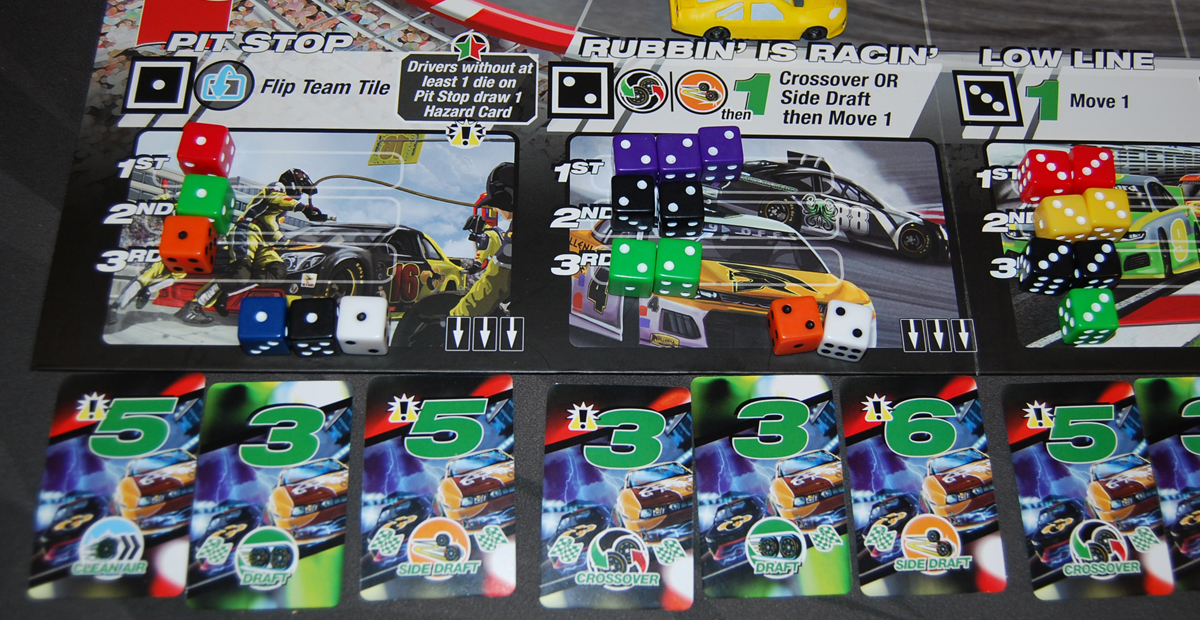
Once everyone is out of dice, you award cards and resolve awards and penalties. Reveal all the Thunder cards below the board. For each action space, the top 3 players in order get to take those Thunder cards. Any player that did not place at least 1 die in Pit Stop must draw a Hazard card and also takes a red flag. Any player who placed dice in Low Line but did not get a card gets to move 2 spaces on the track. If there are more than 6 players, each player is dealt 1 Thunder card from the deck.
Anyone who has fewer than 4 Thunder cards draws cards from the Speed deck until they have 4 race cards total (not counting Hazards). Anyone who has more than 4 Thunder cards must discard down to 4.
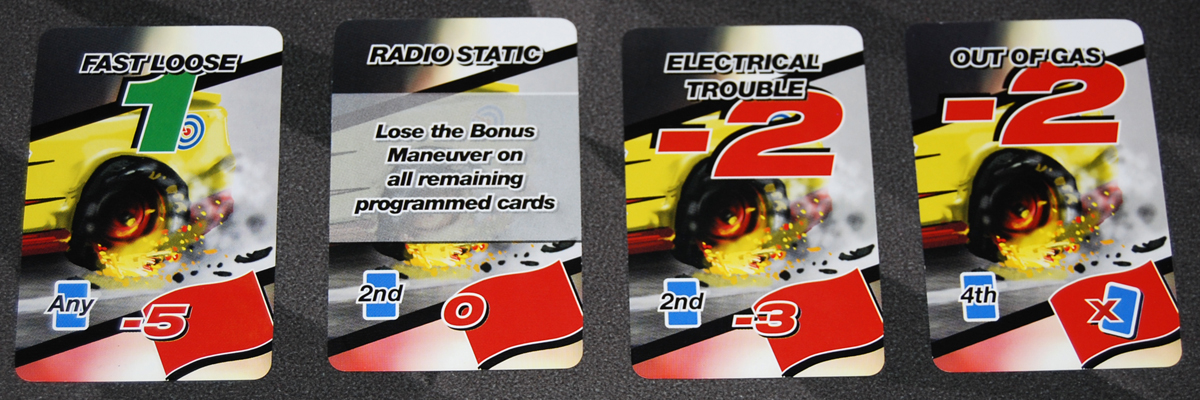
Thunder Phase
For every Thunder card that has a Hazard symbol on it, you must roll a die—if you roll a 1, you draw a Hazard card. Each Hazard card shows where it must be placed in your program. Some Hazards have red flags—these are additional penalties you suffer if you did not take the Pit Stop action during the Rolling phase.
Then, every player programs their four race cards. (Race cards stack with the Hazard cards.)
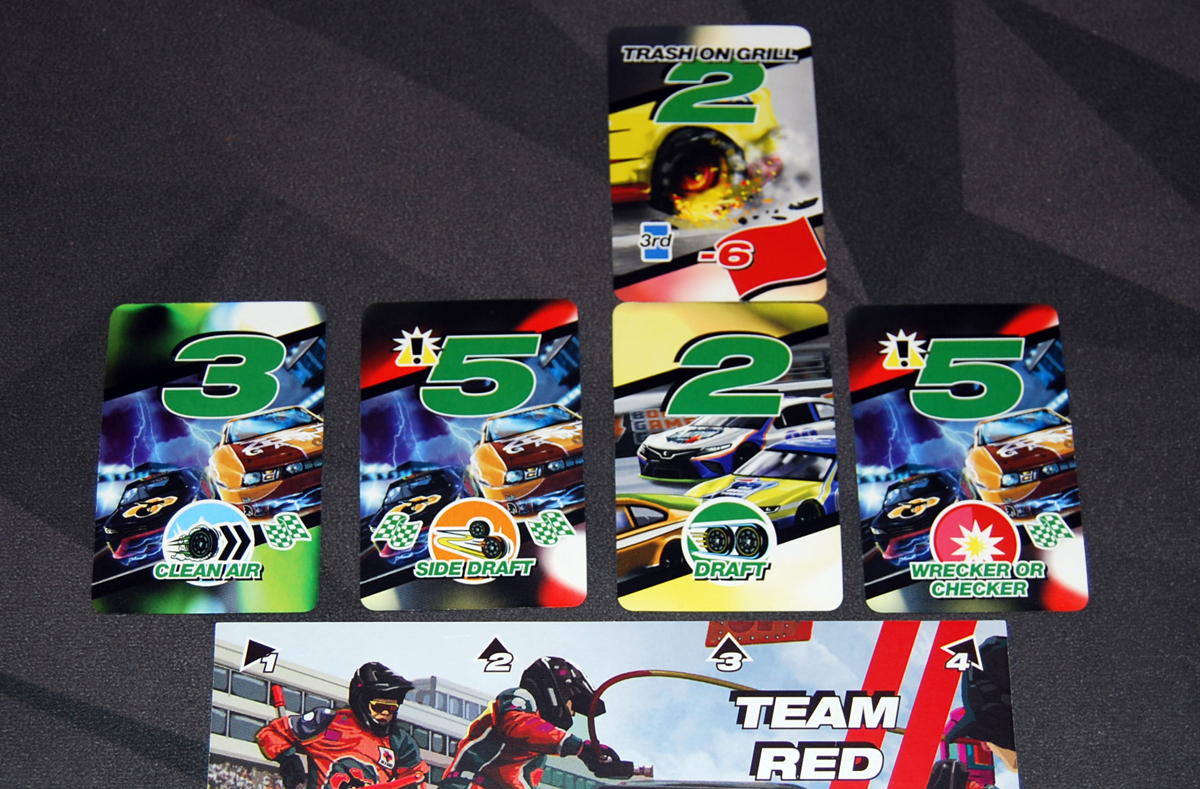
Starting with the leader and going clockwise, players reveal the cards in the first slot and perform its action. If there’s a Hazard, reveal it and resolve it first, and then resolve your race card. Note: If you have a Hazard, then you lose any maneuver printed on your race card and you only get the movement number.
After all the players have gone, draw one NPD Action card for each NPD and use the bottom half showing the “Thunder Phase” action.
Repeat until everyone has played all 4 of their actions.
At the end of the Thunder phase, players also get bonus moves if they have paired flag icons in their program. (In the photo above, Team Red has one pair of flags on cards 1 and 2, so they get to move 2 spaces.) Then, points are awarded—fewer points after the first Stage, and more points at the conclusion of the race in the second Stage. (Reshuffle cards and set up again if playing another stage, skipping the Qualifying step.)
Other Details
There are several maneuvers seen on some of the action spaces or on race cards:
- Clean Air – If the two spaces directly in front of you are empty at the start of your move, then add 2 movement.
- Crossover – Before or after your move, you may swap spaces with a car that is directly in front of you, or diagonally adjacent in front of you.
- Drafting – Before or after your move, if you are directly behind or in front of another car, both cars may move 1 space.
- Side Draft – Before or after your move, if there is a car directly adjacent to your side, you may push that car backward 1 space. (This may push other cars backward as well.)
- Work the Pack – Before or after your move, trade places up to three times with adjacent cars.
- Wrecker or Checker – After your move, move an additional 1–6 spaces and then roll a die. If you roll equal to or higher than your bonus move, you stay. Otherwise, you lose the bonus move and move an additional 3 spaces backward as a penalty.
- Horsepower – After your move, move an additional number of spaces equal to your current position. (For example, first place would move 1 extra space.)
Generally when you move, you may move forward orthogonally or diagonally. If your path is blocked, you may brake to stop moving, or you may push—but that can trigger a risk test, where each involved car rolls a die. Any dice that match cause those cars to move backward 2 spaces (or more if needed to reach an empty space).
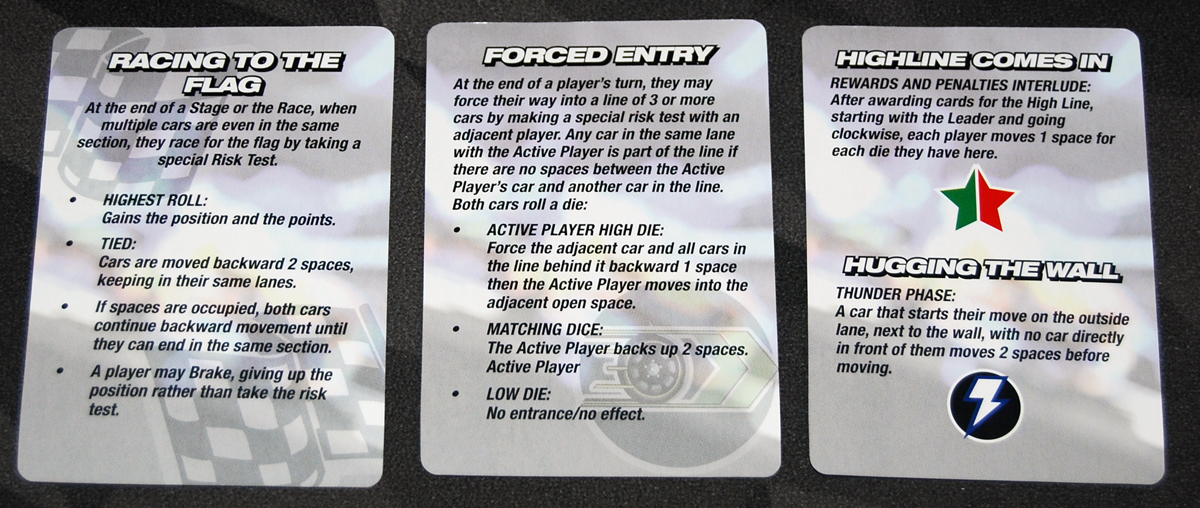
There are also some Advanced Rules cards—you can add one of these to any race to spice things up. There are also Weather cards—you draw a new one at the start of each phase, and these can affect the track conditions as you drive.
Game End
After the prescribed number of stages, the race ends, and players are placed according to their position on the track. (If playing a multi-race championship, award points and set up for the next race!)
Thunder Rolls is GeekDad Approved!
Why You Should Play Thunder Rolls
I’m not a huge NASCAR fan, so the theme of Thunder Rolls didn’t grab me right from the start, but I do like chucking dice and programmed movement games. The fact that it was designed by Richard Launius also piqued my curiosity—he’s designed quite a few well-known games like Arkham Horror and Defenders of the Realm, and he’s a fan of stock car racing, too. So it seemed worth taking out for a few laps around the track. When I got to play the prototype, I ended up really enjoying it, so I was really excited to get a review copy of it in February this year, in time to paint up the cars for my local gaming convention.
Taran Kratz, the developer and one of the co-publishers, told me that Thunder Rolls is better the more players you have, and I would agree. You always have 8 cars on the track regardless of the number of players, using the non-player driver cards to control the others—but, really, they’re just not as smart and can sometimes choose actions that don’t move them at all. The more players you have, the fewer NPDs you have to resolve, which is nice. I generally haven’t been playing this at lower player counts but if I have 6 to 8 players then this has become one of my go-to options for bigger groups.
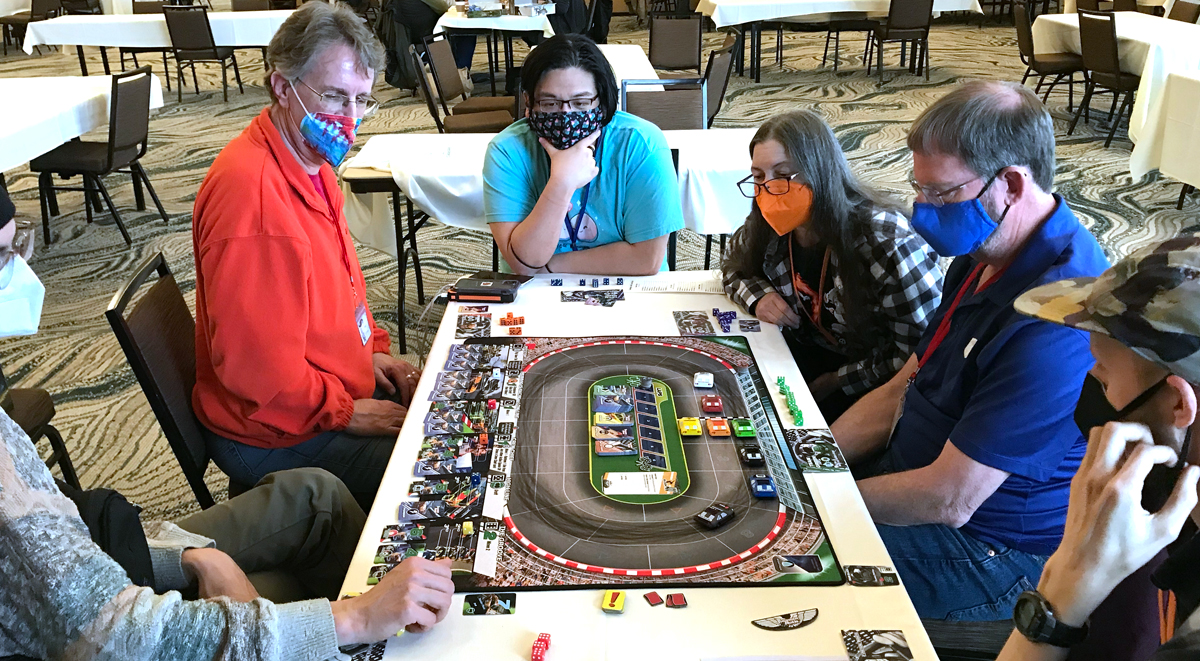
The dice placement in the Rolling phase is when there will be a lot of jockeying for position, both on the track and in the action spaces themselves. You’re limited, of course, in what numbers you manage to roll, but then you have to decide which set to use. If you use a number that you rolled a lot of, then you’re committing more dice to that spot—good for getting a Thunder card, but it means you have fewer total actions during the Rolling phase. The Crew Chief spot is great for retrieving some dice from a location where you already have a solid lead (or where you’ve lost the lead and don’t think you’ll get it back), but you have to decide between getting another action (by taking a die) or taking a chance on a Crew Chief card. The cards can be quite powerful, but are also situational so if you’re not in the right position it may not help you as much.
There’s also the tricky question of when to take a pit stop—at the beginning of the game you don’t need to refresh your team card, so you may feel like it’s not necessary to place those 1s right away, especially if you rolled several of them. It just seems like such a waste to commit so many dice to an almost useless action! But as the round continues, you’ll have fewer and fewer dice, and at some point you may regret that you didn’t take the pit stop when you had the chance. No pit stop means you automatically draw a Hazard, and it also means that many of the Hazard cards have even worse effects. Depending on the race, there are sometimes additional penalties if you don’t have “fresh tires,” so that’s another reason to take a pit stop if you’ve used your tile to reroll dice.
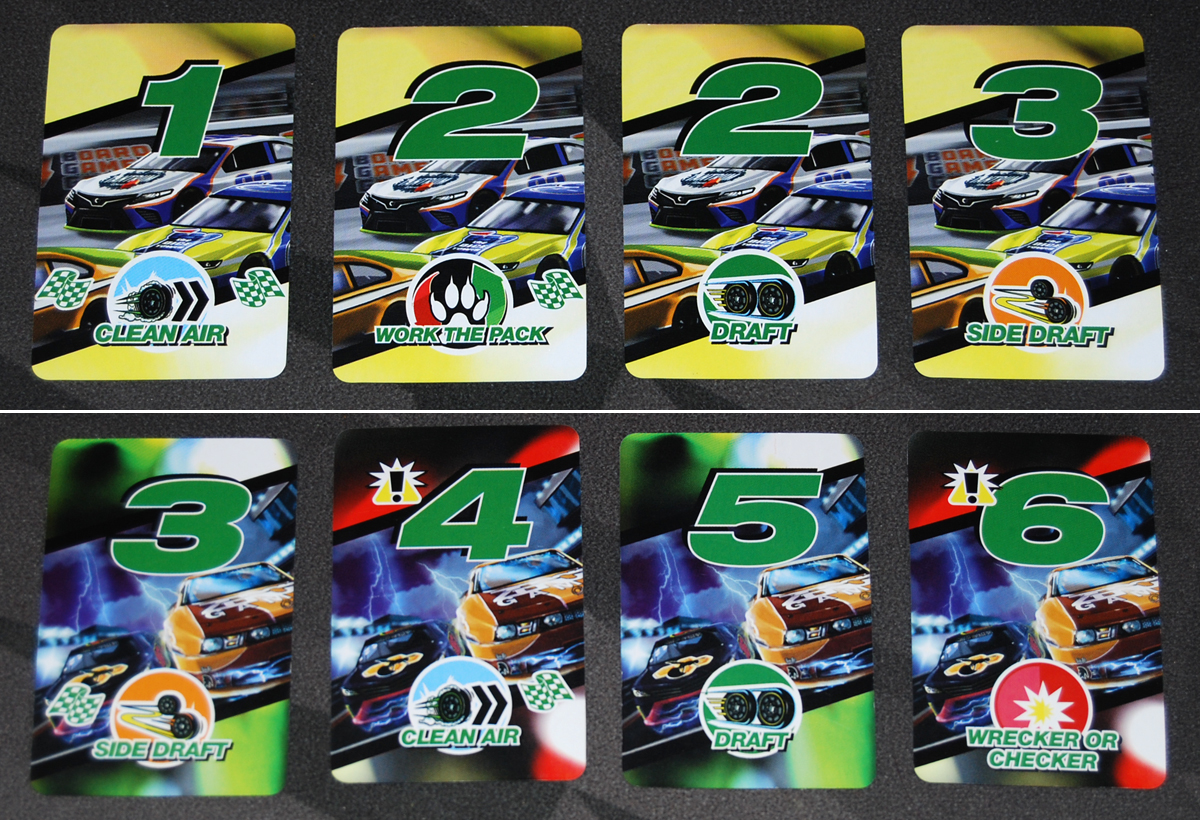
The Thunder phase is the programming half of the game, and that’s where things speed up. The dice action spaces move you 1 or 2 spaces at most, but if you’re really lucky with a Wrecker or Checker gamble, you could move as much as 12 spaces total. Each card has both a movement and a bonus action, so you want to try to position yourself each time so that the action is useful—plus, if you can, you want to order your cards so that you have matching pairs of flags, because those will give you some bonus movement at the end of the phase.
The cars on the track are intended to represent the relative position of the cars in the race, not absolute position: you aren’t literally going backward on the track, but the idea is that everyone else has gained position relative to you. The one downside is that you can gain and lose laps, if you get moved back and forth near the checkered line, and that can be a bit confusing to track. I often forget to move the tokens when somebody crosses the line. Also, where most race games run a set number of laps around the track, Thunder Rolls just has a set number of rounds, and then whoever’s farthest ahead is the winner. It can feel a little odd that the end of the race isn’t tied to crossing a finish line, but I like the way that it makes the game length a bit more predictable, because you know how many stages it will be.
With all the crossovers and drafting, there’s a lot of swapping around that can happen in both phases of the game, but only when you’re near other cars. Fortunately, the track is small enough that you’re generally not too far from a couple cars, though it’s not guaranteed that you can get into the right position for every bonus action.
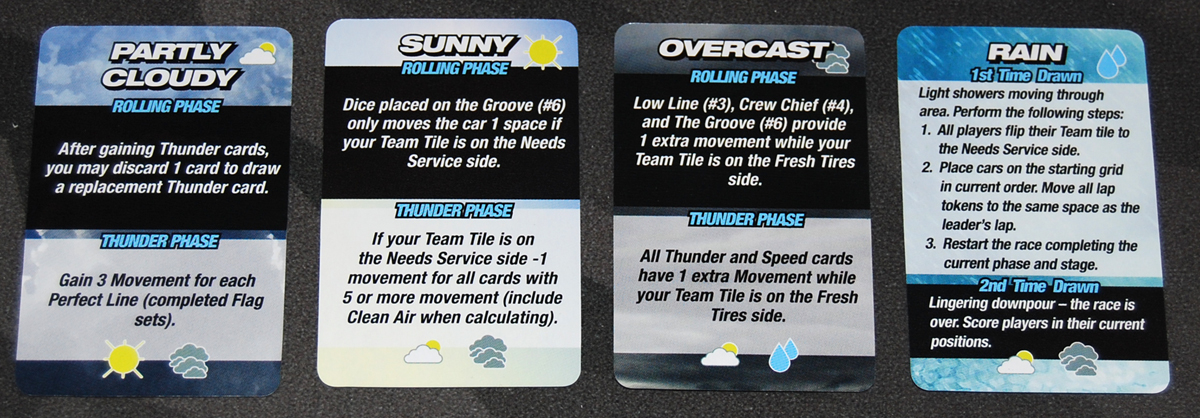
The various races add some flavor to the game, too, changing up the track that you use and introducing special rules for the race. One gives bonuses for being on the outside wall; another boosts the Crew Chief action and lets you skip the pit stops. They can really change up the feel of the game with just some small tweaks. And, of course, the mix of weather and advanced cards can throw in even more variety and thematic flavor.

Thunder Rolls does have a high luck factor, of course—sometimes you just get unfortunate or unlikely rolls and you just feel stuck. In some of the games I’ve played, there have been a few players who just kept getting bumped backward, both by other players and by the NPDs, and that can be frustrating. However, if you’re primed for a game that has a bit of random chance and chaos, it can be quite fun even if you’re not in the lead.
While you can pick up a copy of Thunder Rolls now, there’s also a new Kickstarter campaign running for an expansion, The Garage, which will add more setup cards, more Crew Chief cards, some more advanced rules and race cards, and a few other bonuses. There’s also an add-on for another set of cars—the extra set comes in colored plastic rather than white, which is a nice bonus that would have saved me some painting!

I’ve given Thunder Rolls our GeekDad Approved seal—it’s a really fun game for a big group with a good mix of luck and tactics, and you can enjoy it even if you (like me) aren’t much for actual car racing.
Click here to see all our tabletop game reviews.
![]() To subscribe to GeekDad’s tabletop gaming coverage, please copy this link and add it to your RSS reader.
To subscribe to GeekDad’s tabletop gaming coverage, please copy this link and add it to your RSS reader.
Disclosure: GeekDad was loaned a prototype of this game for review purposes.

